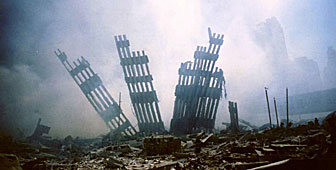Insurance burden grows as global loss of life increases

Man-made and natural catastrophes claimed more than 33,000 lives in 2001, according to a new report published on Wednesday.
Swiss Re, the world’s second largest reinsurance company, also said in its survey that liability and life insurance losses relating to the September 11 terrorist attacks in the United States are now estimated at between $16.5 billion (SFr28 billion) and $39 billion.
“2001 would have gone down as an average loss year had it not been for 11 September,” Swiss Re said in its annual report into the state of the global insurance industry.
“This event confronted the insurance industry with an entirely new loss dimension,” the report concludes.
Aurelia Zanetti, spokeswoman for Swiss Re, told swissinfo total losses last year were “unexpected”.
“The political dimension is new, since primarily in the past we have dealt with natural phenomena, and now terrorism has assumed an international dimension since September 11,” Zanetti commented.
Swiss Re would not be drawn on whether the heightened threat of international terrorist attack would affect the future level of insurance premiums.
Loss of life
The company reports that around 3,000 people lost their lives in the attacks on the World Trade Center in New York and the Pentagon in Washington.
The biggest single natural disaster of 2001 was the devastating earthquake which struck the southern Indian state of Gujarat. Swiss Re estimates that around 15,500 people died in the quake.
Despite the enormous loss of life, the company describes the total number of natural catastrophes in 2001 as “a little below the long-term average”.
Nevertheless, says Zanetti, the risk of natural disaster is likely to increase over the next decade.
“There is a trend towards higher population densities, higher concentrations in exposed areas and so we think that there is evidence that the trend towards higher risks persists,” she said.
“There are not only higher populations, but also more people for example in coastal zones, which are particularly exposed to storms, so the number of fatalities could increase.”
swissinfo with agencies

In compliance with the JTI standards
More: SWI swissinfo.ch certified by the Journalism Trust Initiative
You can find an overview of ongoing debates with our journalists here. Please join us!
If you want to start a conversation about a topic raised in this article or want to report factual errors, email us at english@swissinfo.ch.